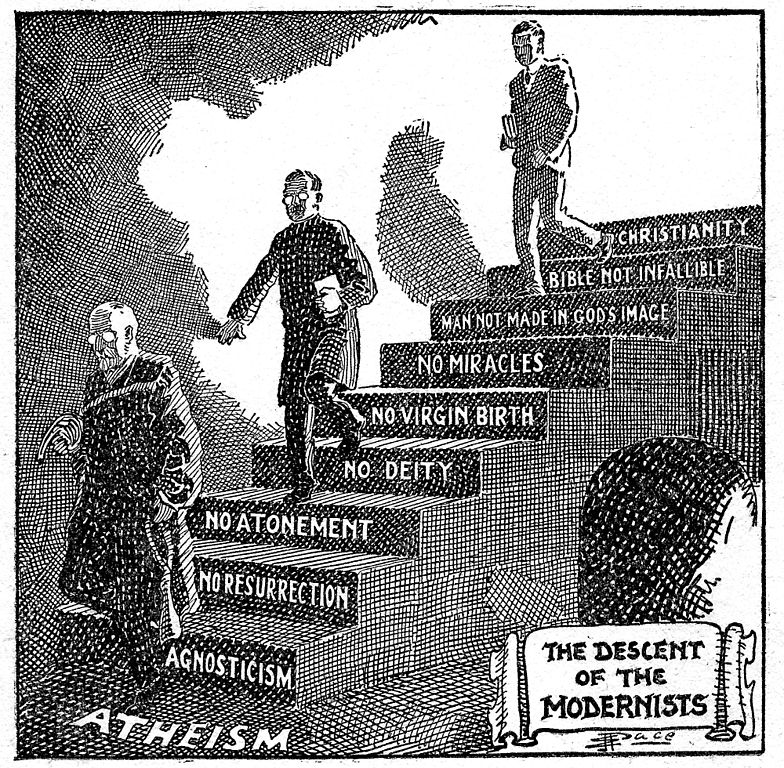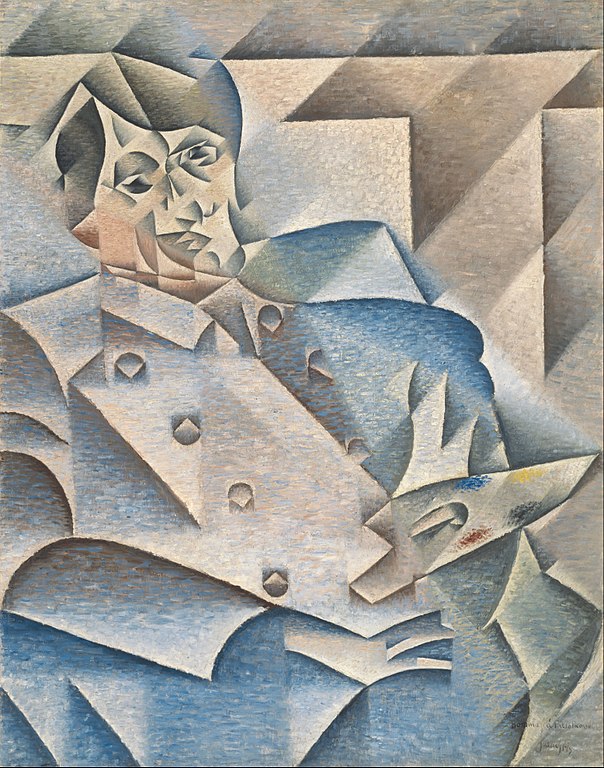Part I: Modernism
Modernism (1900-1945)

This unit introduces texts from the Modernist period in Europe, Asia, the United States, and the Middle East. The philosophical movement in art and literature that we call “Modernism” was characterized by the artist’s response to two powerful forces: the effects of industrialization and the aftermath of wars, particularly the Russian Revolution and World War I. Modernist writers and artists rejected the certainties of Victorian culture, particularly conventional religious faith and respect for authority. Perhaps the most fundamental underlying tenet of Modernism is that traditional ways of thinking about art, music, literature, government, religion, sex, civil rights, architecture, fashion, and other aspects of daily life should be questioned and re-invented.

“The Descent of the Modernists”, by E. J. Pace, first appearing in the book Seven Questions in Dispute by William Jennings Bryan, 1924. License: Public Domain.
We can trace the roots of Modernism to writers, artists, poets and philosophers of the late 19th century. For example, Sigmund Freud’s theories on the importance of the unconscious, published between 1899 and 1930, certainly influenced writers like Virginia Woolf, James Joyce, and T.S. Eliot to explore the interior lives of their protagonists. Thus, the use of internal monologues and stream-of-consciousness techniques became an important characteristic of Modernist poetry and fiction. Frederic Nietzsche’s theory of “the will to power,” his argument that the primary driving force in humans is toward achievement and success, also influenced novelists and short story writers like Dorothy Richardson and Katherine Mansfield. Critics generally point to such writers and playwrights as August Strindberg, Anton Chekhov, Fyodor Dostoyevsky, W.B. Yeats, Henry James, and Charles Baudelaire as exhibiting experimental techniques and themes that would come to be associated with Modernism. The Impressionist, Expressionist and Cubist movements in visual arts, encompassing artists like Edouard Manet, Claude Monet, Vassily Kandinsky, Henri Matisse, and Pablo Picasso also typify the spirit of resistance and a desire to create art that spoke to the contemporary condition of men and women in a rapidly changing world.

Portrait of Pablo Picasso by Juan Gris. License: Public Domain.
Blast magazine (1914), an avant garde publication that lasted only two issues, published a manifesto that reflects some of the impulses and contradictions of Modernism. While the manifesto was signed by a number of artists and writers who identified as members of the Vorticist movement, its chief architect was Wyndham Lewis, an English painter and critic. The Vorticists, like the Futurists in Italy, attacked traditional art and literature and celebrated the power and energy of technology. Vorticists celebrated England as the vortex of youthful energy and power. They rejected the bourgeois values and stifling convention of Victorianism and advocated for violent change. Vorticists considered themselves to be “Primitive Mercenaries in the Modern World” and arguing that “The artist of the modern movement is a savage . . . this enormous, jangling, journalistic, fairy desert of modern life serves him as Nature did more technically primitive man.”
Another influential Modernist publication is Virginia Woolf’s 1921 essay “Modern Fiction,” in which Woolf exhorts writers to reject the trivialities of the realistic approach in favor of free expression and form that will reflect the complexity of modern life: “Life is not a series of gig lamps symmetrically arranged; life is a luminous halo, a semi-transparent envelope surrounding us from the beginning of consciousness to the end.” Meanwhile, iconoclastic American poet Ezra Pound exhorted fellow poets and writers to “make it new.” Woolf’s and Pound’s exhortations to re-imagine traditional literary genres reflects the spirit of Modernism and influenced many of their fellow writers and poets.
In the United States, this period also ushered in the Harlem Renaissance, a “golden age” for African American literature, art, and music that is generally dated from 1918 to the mid-1930s and was centered in the Harlem district in New York City. Like the original Renaissance, this movement saw an explosion of creative energy that resulted in extraordinary works that both documented the African American experience and experimented with style and genre. Writers, poets, philosophers, musicians, and visual artists like Langston Hughes, W.E.B. DuBois, Zora Neal Hurston, Claude McKay, Louis Armstrong, and Duke Ellington produced works grounded in the “New Negro Movement,” asserting that artistic and intellectual achievement could challenge stereotypes and racism. The pinnacle of the movement is generally considered to be the period between 1924 and 1929, the beginning of the Great Depression.
Modernist writers and poets responded to war, financial collapse, and social change by experimenting with traditional forms and conventions. Given the dramatic events they witnessed, these writers challenged the traditional Enlightenment view of human beings as primarily rational in texts that explored the chaotic workings of the human unconscious. Poets and writers alike made use of images, symbols, and allusions to mythology and Jungian archetypes. In the theatre as well, playwrights like Luigi Pirandello challenged the comfortable assumptions of audiences by breaking down the “fourth wall” of the play and encouraging members of the audience to think more critically about the action onstage. Reflecting a tumultuous time, the texts that you will read in this unit will challenge you to read deeply and carefully, but their innovations and the ideas they present are exciting and complex.
Written by Anita Turlington

